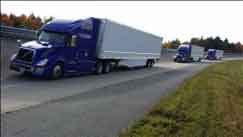About 4% - that was the improvement in miles per gallon performance generally expected to come from so-called truck platooning, which involves the use of vehicle-to-vehicle communications and sensors, such as cameras and radar, to virtually connect two or more trucks together in a convoy.
This allows the trucks to travel with less space between them, reducing drag. In part because a driver would remain in each cab and thus reduce safety concerns, many believed platooning would take hold and be a sort of bridge towards a future world of autonomous trucks.
Supply Chain Digest Says... |
|
| But even if Pelaton and others can generate greater levels of fuel savings than Daimlet is seeing, there are questions. |
 |
What do you say? |
| Click here to send us your comments |
 |
| Click here to see reader feedback |
|
|
But maybe not. Last week, Martin Daum, the head of Daimler's truck and bus divisions, said the major truck maker has decided to pass on platooning and focus instead on advancing its position in vehicle automation. Simply put, Daum said, all the technology required to make platooning work actually produces very limited reductions in operating cost.
Daum added that "testing "currently shows no business case" for the technology on new aerodynamic trucks.
Does the Daimler news indicate the end of the line of truck platooning, before it is even ready for real market tests, after a handful of apparently successful long distance demonstrations? (See Is Truck Platooning Almost Right Around the Corner?)
Not so fast, says Josh Switkes, founder and CEO of Peloton, a leading developer of platooning technology for Class 8 tractor-trailers.
In an interview with Heavy Duty Trucking magazine, Switkes said "Peloton is seeing even better fuel economy results on public roads than we anticipated based on our previous and ongoing track tests. In addition, we have also seen a high utilization of platooning on typical freight lanes."
Switkes also said Pelaton's development and testing of platooning over the last five years has shown "how critical specific functionalities are in the vehicle and the cloud. These include the control of following trucks, as well as the supervision of the platoons by our network operations Cloud. These functionalities, many of which are patented, combine to enable high utilization and the close following distances that do provide good fuel economy improvement."
In other words, maybe Daimler's conclusion came from testing with inferior technology. However, Switkes did not offer a specific number with regard to potential fuel savings.
Swikes then commented on the idea that the Daimler announcement is a signal that platooning may be more of an aftermarket solution for fleets, as opposed to technology offered by truck OEMS.
That is possible, Switkes said, noting that Peloton has developed its platooning system to be interoperable across OEMs and fleets, and could just be an add-on that truck dealers, carriers, and/or private fleets add themselves.
(See More Below)
|
CATEGORY SPONSOR: SOFTEON |
|
|
| |
|
|
 One of the reason proponents were bullish on truck platooning's future is what appears to be a much more friendly regulatory environment than that for driverless trucks. States including Nevada, Ohio and more have indicated strong support for testing and eventual adoption of platooning systems. One of the reason proponents were bullish on truck platooning's future is what appears to be a much more friendly regulatory environment than that for driverless trucks. States including Nevada, Ohio and more have indicated strong support for testing and eventual adoption of platooning systems.
Switkes told HDT that "We have seen tremendous traction on regulations supporting platooning over the past year, with the majority of the freight ton miles now occurring in 18 platooning-approved states."
Just recently, consulting firm McKinsey saw platooning as the first of four stages that will end with fully autonomous trucking – sometime after 2017.
It predicted that in five to seven years, platooning with a driver in only the lead truck could save the industry 10% in operating cost, noting the US Army next year will test driverless platooning on two U.S. bases.
But even if Pelaton and others can generate greater levels of fuel savings than Daimlet is seeing, there are questions.
Those include the fact that the fuel-efficiency gains are only achieved in long-distance, highway-speed trips. And there are questions about whether all three trucks in a platoon would have to be from the same carrier, all using the exact same system, limiting its applicability.
Do you think there is a future for platooning? Why or why not? Let us know your thoughts at the Feedback section below.
Your Comments/Feedback
|